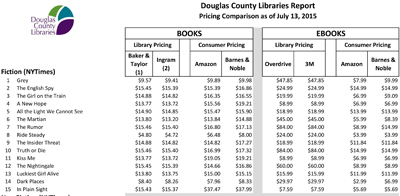
Isn’t it just an amazing coincidence how similar the prices are from OverDrive and 3M? Take Elin Hilderbrand’s The Rumor, selling for $84 to libraries, but available to consumers for $14.99, as shown in the July 2015 Douglas County Libraries Report (PDF). What, do you imagine, is the discount for distributors on such a title? I asked several distributors at a Texas Library Association panel if it was true they got a 55% discount. (I was fishing for the upper limit.) All of them immediately protested: no! And I believe them. So let’s say it’s something close to the bookstore discount: 45%. If so, they would pay $37.80 for The Rumor and make $46.20 on the sale to us—a profit of more than three times the cost to a consumer.
By contrast, the bookstore gets a 45% discount off the consumer price ($6.75) and makes $8.24. Having worked in bookstores myself, I know the margin is slim, and I have no quarrel with it.
But I do have a quarrel with the library price. It is set, distributors assure me, by the publisher. But here’s my next question. Should publishers have the right to set the consumer price? Couldn’t a distributor accept whatever price the publisher establishes ($37.80) but then allow the distributor to take a slightly lower margin on the sale to libraries, thereby reducing the cost? If they do not allow this, why not? It has no effect on the consumer price. It has no effect on their own profit.
My point is this: Libraries and taxpayers who support libraries are being ripped off in ways that not only outrageously inflate the payment to publishers (surely their costs are not three times greater to provide the book to us than to the consumer), they also greatly reward distributors. The result? At a time when about half of our patrons use e-readers, we barely offer 10% of our collections to them in their preferred format.
When does a vicious price become complicity between publisher and distributor, to the detriment of the public?
